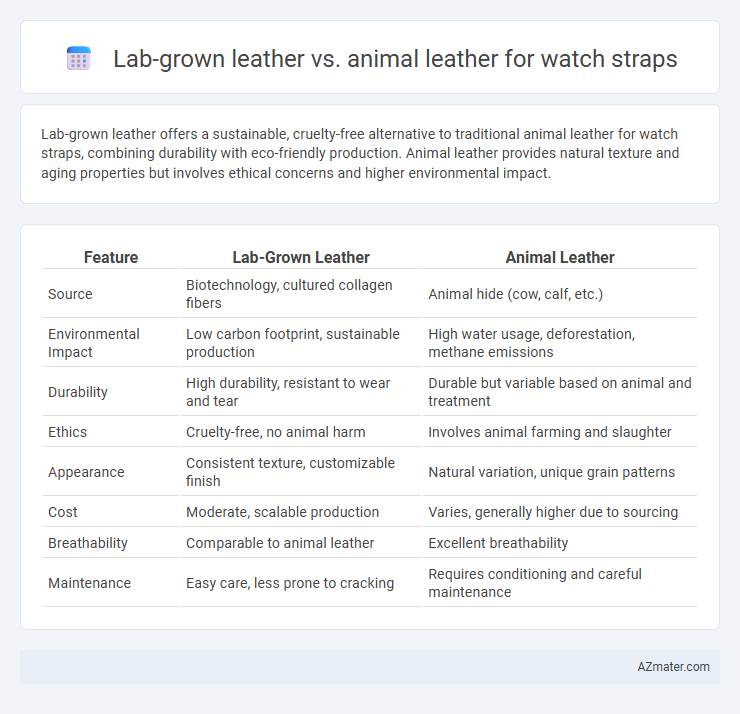Lab-grown leather offers a sustainable, cruelty-free alternative to traditional animal leather for watch straps, combining durability with eco-friendly production. Animal leather provides natural texture and aging properties but involves ethical concerns and higher environmental impact.
Table of Comparison
| Feature | Lab-Grown Leather | Animal Leather |
|---|---|---|
| Source | Biotechnology, cultured collagen fibers | Animal hide (cow, calf, etc.) |
| Environmental Impact | Low carbon footprint, sustainable production | High water usage, deforestation, methane emissions |
| Durability | High durability, resistant to wear and tear | Durable but variable based on animal and treatment |
| Ethics | Cruelty-free, no animal harm | Involves animal farming and slaughter |
| Appearance | Consistent texture, customizable finish | Natural variation, unique grain patterns |
| Cost | Moderate, scalable production | Varies, generally higher due to sourcing |
| Breathability | Comparable to animal leather | Excellent breathability |
| Maintenance | Easy care, less prone to cracking | Requires conditioning and careful maintenance |
Introduction to Lab-Grown and Animal Leather
Lab-grown leather for watch straps is created using innovative bioengineering techniques that replicate the texture and durability of traditional leather while minimizing environmental impact. Animal leather, derived from livestock such as cows, offers natural strength and classic aesthetics but involves resource-intensive processes and ethical concerns related to animal welfare. The choice between lab-grown and animal leather hinges on balancing sustainability, quality, and consumer preferences in luxury watch accessories.
What is Lab-Grown Leather?
Lab-grown leather, also known as bio-fabricated or cultured leather, is produced by cultivating animal cells in a controlled environment without the need to raise or slaughter animals. This innovative material mimics the texture, durability, and aesthetic qualities of traditional animal leather, making it an eco-friendly and cruelty-free alternative for watch straps. It significantly reduces the environmental impact by minimizing water usage, greenhouse gas emissions, and land degradation compared to conventional leather production.
Animal Leather: Source and Production Process
Animal leather for watch straps is primarily sourced from cattle hides, undergoing a complex tanning process that converts raw hides into durable material. The production involves stages such as curing, soaking, tanning with chromium salts or vegetable tannins, and finishing to enhance texture and color. This traditional method produces a high-quality, breathable strap that is prized for its natural grain and longevity.
Environmental Impact: Lab-Grown vs Animal Leather
Lab-grown leather significantly reduces environmental impact by utilizing sustainable materials and minimizing water consumption, land use, and greenhouse gas emissions compared to traditional animal leather production. Animal leather manufacturing involves intensive resource use, deforestation, and chemical pollution from tanning processes, contributing to biodiversity loss and higher carbon footprints. Choosing lab-grown leather for watch straps promotes eco-friendly practices and supports reduced ecological degradation in the fashion industry.
Durability and Longevity Comparison
Lab-grown leather for watch straps offers enhanced durability due to its uniform material structure and resistance to cracking, unlike traditional animal leather which can deteriorate with exposure to moisture and sunlight. Synthetic processes in lab-grown leather improve longevity by minimizing natural wear and tear, maintaining appearance and flexibility over time. Animal leather, although prized for its natural texture, often requires regular maintenance to sustain its durability and prevent fading or stretching.
Aesthetics and Feel: Lab-Grown vs Animal Leather Straps
Lab-grown leather watch straps offer a consistent texture and rich finish that closely mimics the natural grain and suppleness of animal leather, providing a smooth, luxurious feel. Animal leather straps, prized for their unique patina and natural irregularities, develop a personalized character and softness over time with wear. Both materials deliver premium aesthetics, but lab-grown leather excels in uniformity and sustainability, while animal leather remains favored for its traditional elegance and tactile warmth.
Cost Analysis: Price Differences
Lab-grown leather for watch straps generally costs 20-40% less than traditional animal leather due to lower production expenses and reduced resource consumption. Animal leather prices fluctuate based on factors such as breed, tanning method, and geographic origin, often ranging from $50 to $200 per square foot. Lab-grown alternatives provide consistent pricing with scalable manufacturing, making them a cost-effective option for luxury and mass-market watch straps.
Ethical Considerations for Consumers
Lab-grown leather offers an ethical alternative to traditional animal leather by eliminating the need for animal slaughter and reducing environmental impact, appealing to consumers concerned with animal welfare and sustainability. Animal leather production involves significant ethical issues related to animal rights, factory farming, and ecological harm, including deforestation and high carbon emissions. Consumers prioritizing cruelty-free products increasingly prefer lab-grown leather for watch straps, as it aligns with values promoting animal protection and environmental responsibility.
Market Availability and Brand Adoption
Lab-grown leather for watch straps is gaining traction in the fashion industry, with increasing market availability driven by sustainable luxury brands such as Gucci and Hermes integrating these alternatives into their collections. Animal leather remains dominant in the market, but the rise of lab-grown options reflects consumer demand for cruelty-free, eco-friendly materials without compromising on durability and aesthetics. Widespread brand adoption of lab-grown leather is accelerating due to advancements in production technology and growing environmental concerns among consumers.
Which is Better for Watch Straps?
Lab-grown leather for watch straps offers superior sustainability and consistent texture compared to traditional animal leather, reducing environmental impact and ethical concerns. Animal leather provides natural durability and develops a unique patina over time, valued by luxury watch enthusiasts for its authenticity and timeless appeal. Choosing between the two depends on prioritizing eco-friendliness and innovation versus classic craftsmanship and heritage.

Infographic: Lab-grown leather vs Animal leather for Watch strap
 azmater.com
azmater.com